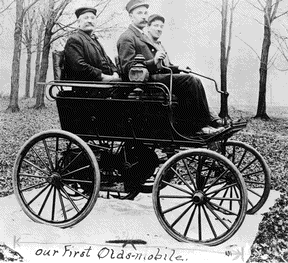the automobile was revolutionary compared to the the railroad because it allowed individualized travel
automobiles and automobility:
- not just the origins of the automobile but also its impact
- predictable consequences such as the need for gas
stations
and more production of gasoline
- an unintended consequence is pollution
- the automobile particularly fits American values of freedom (of movement at least) and privacy
- the automobile reshapes the way we live--the automobile age
- Cowan's concept of automobility is trying to get at
these
things.
before that there was the horse and carriage
- carriages weren't common until the 18th century even in Europe because roads weren't good enough
- early colonial roads were cleared paths that quickly became rutted, not to mention the problem of mud
- if you wanted to transport a heavy load in New England you waited until winter and used a sleigh
- the most characteristic carriage in the U.S. was the American buggy--lightweight practical vehicles
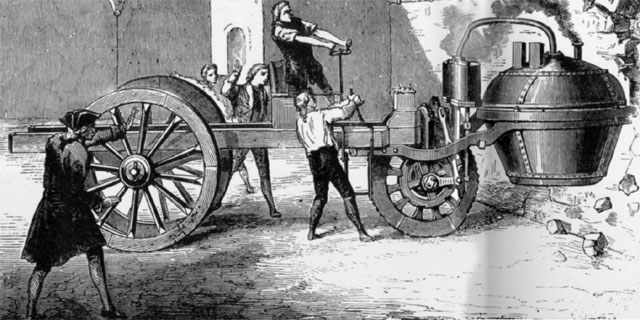
- A French artillery officer, Nicholas Joseph Cugnot, built and ran a 3 wheeled carriage powered by a steam engine in 1769, but which ran off the road the first time it went into a curve at its full speed--3 miles and hour. It was the first self-propelled highway vehicle, but it was no improvement over the horse.
- Some steam powered busses were actually used commercially in England in the first half of the 19th century, but once the railroad took off it was clearly superior.
- The railroad and stagecoach industries succeeded in having a law passed to stop these in 1865 (repealed 1896)--on the ground of the dangers of frightening horses self-propelled vehicles on public highways were limited to a speed of 4 miles an hour and had to be preceded by a man on foot carrying a red flag
- Etienne Lenoir (a Belgian mechanic working in Paris) developed a workable two cycle internal combustion engine in 1860, but it weighed several hundred pounds and developed 2 horsepower. He actually built and ran a vehicle using his engine, but it was an isolated experiment that didn't lead to anything.
- Nicholas Otto did better with a four stroke engine, and a number of German inventors immediately wanted to put it in a road vehicle. Gottlieb Daimler and Wilhelm Maybach and Karl Benz built the first workable vehicles with one cylinder engines (first a motorcycle and a tricycle) and developed workable automobiles in the 1880s and had them in commercial production in the early 1890s. Significant commercial production developed in the 1890s in Germany and France (whose advantage was good roads), with Britain trying to catch up. These were mostly playthings for wealthy sportsmen, though by 1900 touring cars were used some by wealthy families instead of carriages and there was some use of electric automobiles by wealthy ladies in the city.
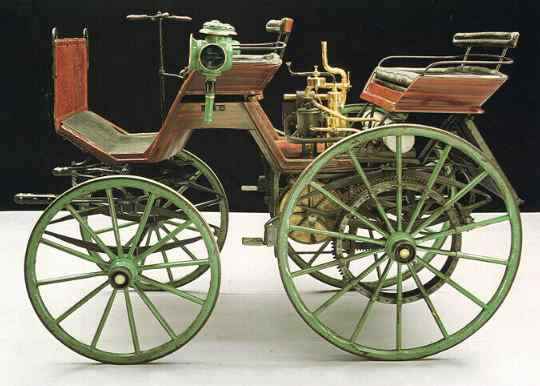
Daimler 1886
you also needed decent roads, and the bicycle boom provided these, as well as a sense of the market. The automobile probably could have been built 20 years earlier, but the interest was not there.
- J. K. Starley introduced the safety bicycle in 1885. People had been satisfied with the railroad--only with the bicycle did they think of long-distance travel over ordinary roads.
- the pneumatic tire was invented by John Dunlop in Ireland in 1888 specifically for use in bicycles
- the automobile would not have been able to compete with the railroad in comfort and speed without the hard-surface road and the pneumatic tire
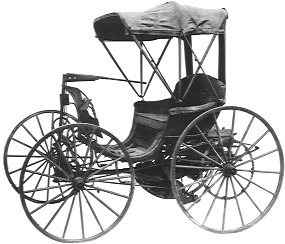
1893 Duryea
- The first American automobile was developed by two brothers who were bicycle mechanics--Charles and Frank Duryea--who copied a published description (Scientific American, 1889) of Benz's automobile and built a motor car with a one cylinder engine in 1893. Others quickly followed--the Chicago Times Herald sponsored the first American automobile race in 1895, which was won by Frank Duryea who covered a 55 mile course at an average speed of 8 miles an hour with a two cylinder automobile
- this led to a lot of
very
amateur re-inventing. Hiram
Percy Maxim
, son of the inventor of the Maxim gun and an MIT
graduate, claimed he
had the idea for a powered vehicle when he was bicycling
home late one
night after a romantic evening. He knew that
internal-combustion
engines existed and might provide the mechanism he
wanted, but he had
never seen one, so he went to see a natural-gas powered
Otto engine
working a pump. He did not know if gasoline could
be used as a
fuel--he was completely unaware of what had been done in
Europe and by
the Duryeas. So he took himself to a remote corner
of the land of
the American Projectile Company where he worked with a
half a pint of
gasoline and some empty cartridge cases to find out what
happened when
gasoline was ignited in a cylinder. He was lucky
and didn't kill
himself, but it took him 3 years to develop a workable
engine.
His results attracted the attention of the Pope Bicycle
Company and he
went to Hartford to be chief engineer of Pope's attempt
to establish
the first large-scale commercial production of
automobiles.
Unfortunately Colonel Albert A. Pope thought people the
gasoline engine
was too dangerous ("You can't get people to sit over an
explosion.")
and in two years the company build 500 electric and 40
gasoline
carriages. Maxim went on to pioneer amateur radio.
- in the 1890s the technological choice was not clear, and gasoline, electric and steam cars were built in close to equal numbers. The electric was actually most popular at first, because it was silent, clean, and easy to operate, but battery technology did not allow long runs and high speeds. The early steam cars had more power than gasoline cars and did not require complicated transmissions, but high pressure steam engines required a lot of maintenance, a lot of water, and raised public fears of boiler explosions
- most of the early manufacturers bought parts from suppliers and assembled automobiles one by one--they were not much concerned with improvements of the parts (the part-makers generally had licensed the key technology)
- production rose rapidly
- by 1899 30 companies were producing vehicles commercially and had produced about 2500 vehicles--many were sold through bicycle dealers. In 1900 production was 4,192 units sold for an average price of just over $1000 each.
- in 1908--the year the Model T was born and General Motors was founded, production had risen to 65,000.
- By 1910 458,500 automobiles were registered in the United States, made by something over 1000 different manufacturers
- some manufacturers build cars like carriages--fairly heavy (with a lot of wood) touring cars that were often owned by well-to-do families and driven by chauffeurs who handled the maintenance of the car. Studebaker had been the largest manufacturer of horse-drawn vehicles in the world before turning to automobiles.
- gasoline engines
faced
strong competition from electric automobiles and steam
automobiles
(which may even have been better than gasoline powered
ones for a while)
- other manufacturers imitated the mass production of bicycles--produced a standardized light-weight, low-price automobile. Ford was not the originator of this approach, but rather invented an improved method of mass production. Pope had been a bicycle maker, Pierce-Arrow started out making bird cages, then spokes for bicycle wheels, then complete bicycles and motorcycles, then automobiles. Ransom Olds designed an early low-priced car in 1899 and produced them in large numbers--5,000 in 1904--before deciding to concentrate on touring cars. It wasn't quite an early Model T--it was too small, too light, and too low powered for family transportation. Role of “tinkerers” and technology transfer
Henry
Ford

Ford's beginnings (Ford biography)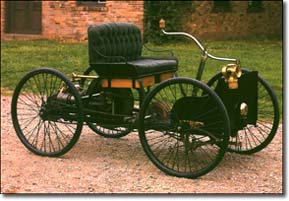
Ford's Quadricycle
Struggle to define the automobile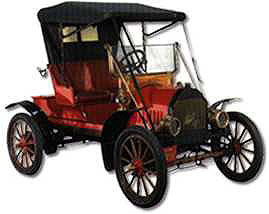
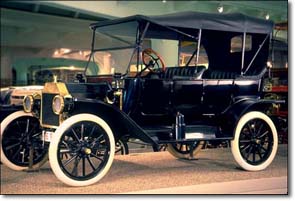
Model T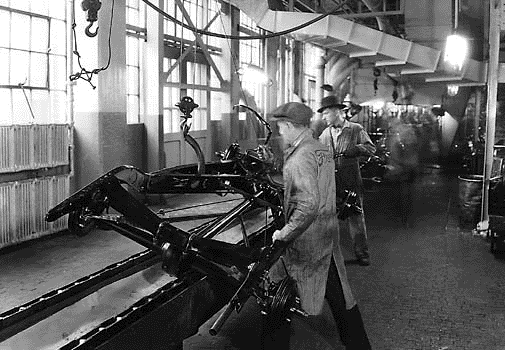
Ford assembly line and Diego Rivera painting (Detroit Institute of Arts)
Model T Automobile Plant from bhere.com site
Meanwhile Sloan at General Motors was revolutionizing organization and marketing
1927 Chevrolet
roads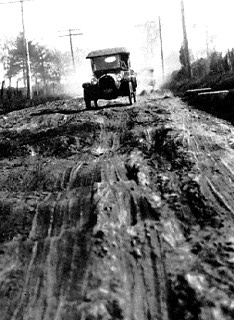

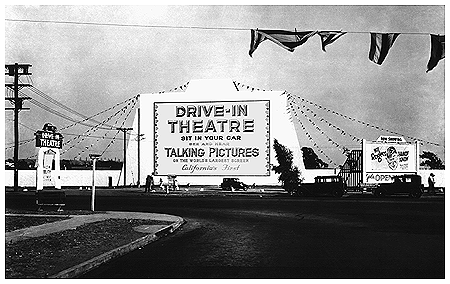
Los Angeles from nhm.org

The interstate highway system
Fuel:
The Gas Station & Auto Service Collectibles Web Site
1930s Shell Gas Station
 Gasoline ( petroleum
history sites
)
Gasoline ( petroleum
history sites
)

Beginnings of the Petroleum Industry
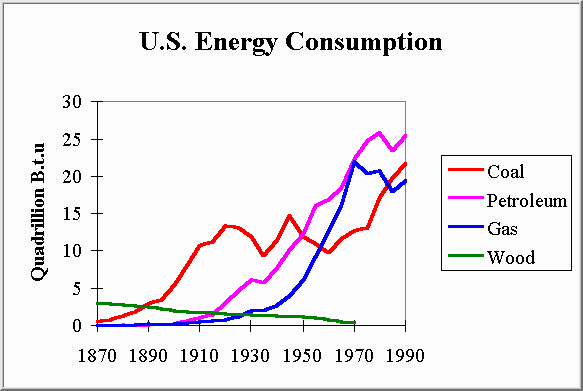
suburbs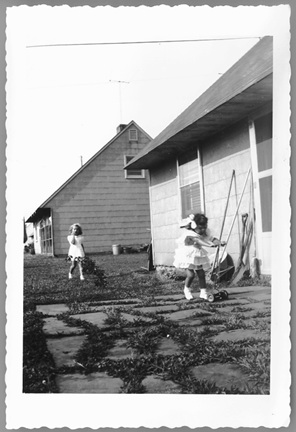

Traffic in Los Angeles, 1949

Ford's beginnings (Ford biography)
- son of a Dearborn farmer, but with a talent for mechanics that led him to a series of engineering jobs before he got into automobiles
- In 1896 Ford was chief engineer of the Edison Illuminating Co. (now Detroit Edison).
- In that year he built a car called the Quadricycle and started looking for backers to produce it commercially (he later claimed to have built a car in 1892 but there is no evidence for that but Ford's claims).

Ford's Quadricycle
- in 1899 he found a group of businessmen to support him, but they got impatient that he was building cars for automobile racing (which he thought was critical publicity) rather than concentrating on setting up commercial production. Ford and his backers parted ways in 1902 and his former backers found another engineer, Henry M. Leland, who gave the company a new name--Cadillac--and got it into commercial production.
Struggle to define the automobile

- Ford started the Ford Motor Company in
1903 with
a new set of backers.
- The Dodge brothers became stockholders in return for providing chassis, engines, and transmissions for the first Ford cars.
- Ford initially made medium-priced cars--$1000-$1500.
- by 1910 the industry was consolidating painfully
- General Motors was about to go under under excessive debt and was saved only by new investors who advanced cash on very harsh terms (6% interest plus a 17% commission).
- many of the smaller companies went bankrupt, and even the larger ones were better at finance than at solving technological problems.
- a number of makers were thinking about low cost cars (an idea that was not tried in Europe until after its success in America). One notable example after the curved dash Oldsmobile was the Brush Runabout, which sold for $500 and had 10 HP and all-wood construction. It didn't hold up very well.
- the key invention of this period was
the electric
starter
- It was invented by Henry M. Leland and Charles F. Kettering. Leland became interested in the problem because a friend of his had died in a bizarre accident. He went to the assistance of a lady whose car had stalled, and when he turned the crank to start it, the crank handle kicked back and broke his jaw. He died of the resulting gangrene.
- the electric starter meant that women and older men could drive cars
Ford first invents a better car, then leads assembly-line revolution (more on Ford as a businessman)
- Ford first designed a mass market car
and then
studied how to cut costs in production. Mass
market meant not
only low cost but sturdy, easy to operate, and easy to
repair.
Ford was one of the first to use alloy steel in
America.
Ford's engineers may have had the idea for the assembly line as early as 1908, but they didn't want to delay introduction of the model T to implement it. The Model T was the first low cost ($825-$850) high power (20 HP) car, also light (about 1,200 pounds) and fairly easy to drive, with a two-speed, foot-controlled "planetary" transmission. It was immediately very popular--compared to cars costing $2000. Ford decided in 1909 to produce nothing else.

Model T
- Ford's business manager had calculated that to really hit the mass market the price had to be brought down to $600, and that could not be done with existing production methods.
- between 1913 and 1914 conveyer belts were introduced throughout the factory
- time required to assemble the chassis fell from 12 hours 30 minutes to 2 hours 40 minutes, and then by 1914 to 1 1/2 hours
- price of Model T dropped to $360 by 1916 and to $290 by 1927 (its last year of production). 577,000 sold in 1916. Within a decade all automobile manufacturers were using the assembly line.

Ford assembly line and Diego Rivera painting (Detroit Institute of Arts)
- now Ford could hire unskilled workers
- He paid average wages: $2.38 for a nine hour day. Workers hated the assembly line and turnover reached over 300%
- in 1914 Ford began to offer selected workers $5 a day and an eight hour day--about twice the going rate in Detroit at the time. At one point fire hoses had to be used to disperse the mob of applicants around the Highland Park plant.
- Between 1914 and 1916, the company's profits doubled from $30 million to $60 million.
- Ford did believe that the gains made by improving techniques of production should be passed on to society in three ways--to stockholders through dividends, to consumers through lower prices, and to labor through higher wages. He understood that the worker was also a consumer. He wasn't fond of stockholders, particularly after the Dodge brothers set themselves up as competitors. In fact in 1916 (a year with record profits) he paid such low dividends that stockholders sued and won. Ford quotes

Model T Automobile Plant from bhere.com site
Meanwhile Sloan at General Motors was revolutionizing organization and marketing
- gave more responsibility to production divisions--decentralized organization
- General Motors made cars for different markets (from Chevrolet at the bottom to Cadillac at the top) and pioneered the annual model change and a choice of colors. Worked out close relations with dealers. Consumers began to look for styling and excitement, not the lowest possible price.
- Ford made the Model T until 1927--15 million of them--nearly driving the company into bankruptcy. Finally when he had to face reality and shut down Model T production he didn't have a new model designed yet.

1927 Chevrolet
roads
road conditions in 1920s

- roads had begun to be improved for bicycles, but the automobile represented the need for a fundamental shift. Conflict between the needs of horses and automobiles--there was a sudden spurt in horseshoe patents to provide horseshoes that would help horses manage paved roads.
- road maps (and street names) were a consequence of the automobile--the first national road atlas was published in 1927
- For the history of licensing drivers see: Licensing Cars and Drivers

- Route 66 from Chicago to Los Angeles opened in 1926 (but it was not limited access)
- the automobile trip culture had
developed by the
1920s--motels,
campgrounds
- the first gas station was opened by Standard Oil in 1912 (gas station museum)
- Visits to national parks increased 4-fold during the 1920s.
- The first drive-in movie opened in 1933 in New Jersey--by the early 1950s there were 4,000 of them.
- A&W root beer stands
- Burma
Shave signs
- The first drive-in restaurant was either Bob's Boy in 1936 or Royce Hailey's Pig Stand in Dallas Texas in the early 1940s (by the 1960s these were haunts for rowdy teenagers and families were looking for another alternative--the chain fast-food restaurant)
- roadside architecture, roadside stores with giant cows, world's largest sixpack, and of course our very own peachoid
- Disneyland opened in 1955--the model for a new generation of amusement parks linked to highways rather than streetcars or trains.

Los Angeles from nhm.org

The interstate highway system
- California opened its first freeway in 1940. In 1947 the state passed a law that expanded the 19 miles of freeway to 300 miles ten years later--by 1980 there were 12,500 miles. 54% of the funding came from the state gasoline tax.
- Began as a cold war idea, with the idea that federal funding was needed to have a system that would allow easy movement of troops. Federal-Aid Highway Act of 1956 committed the country to spending $50 billion to construct 41,000 miles of interstate highways. Good deal for the states--the federal gov't paid 90% of the costs. By 1973 82% had been constructed.
- engineering marvels of the interstate highway system
- Chain motels displaced the old local motor courts--the first Holiday Inn was opened in 1952.

Fuel:
The Gas Station & Auto Service Collectibles Web Site
1930s Shell Gas Station
 Gasoline ( petroleum
history sites
)
Gasoline ( petroleum
history sites
)- Automobiles run on gasoline, a relatively light fraction of crude oil. Diesel fuel (which is essentially the same as home heating oil) is a relatively heavy fraction.
- The heaviest fractions (bitumen or rock asphalt) had been used for centuries for waterproofing and after 1800 for roads. Kerosene was used in lamps from the 1850s.
- In 1859 an American industrialist, George H. Bissell began a deliberate search for oil. They chose a site in Pennsylvania, drilled through 70 feet of bedrock, and used the oil from the well for illuminating gas, lubricating oil, and an excellent lamp oil. Within 15 years production in the Pennsylvania field had reached 10 million (360 lb) barrels a year.
- John D. Rockefeller established Standard Oil in 1870. By building a pipeline system he soon gained control of 90% of a rapidly-growing industry and became for a while the richest person in the world.

Beginnings of the Petroleum Industry
early oil refinery

- The oil was distilled to separate the fractions--first gasoline (1.5 to 15 percent, depending on the crude), which at first was a nuisance because it was highly inflammable and had no use, then kerosene, and then lubricating oil.
- With the popularity of the automobile suddenly gasoline was in greater demand than the other fractions, and cracking was invented by William Burton at Standard Oil in 1913. Heavier fractions are converted into lighter ones by subjecting them to high temperature and pressure to break down the chains of carbon atoms into shorter ones. Industrial research labs competed to find more efficient ways of doing this, most important catalytic cracking with a platinum catalyst in the 1920s.
- problem of engine knock arose just before WWI as refineries tried to widen the cut. Solved by the 1922 introduction of tetraethyl lead as a fueld additive. To prevent lead from fouling the engine ethylene dibromide was added to react with the lead residue and make sure it was funneled out of the exhaust system into the atmosphere (at the time the only questions raised were about hazards of the lead to refinery workers).
- leaded gasoline was phased out starting in the 1970s because the lead that got into the atmosphere and fell into the soil in heavily traveled areas was identified as a significant cause of lead poisoning.

- Have we already hit the peak of oil production?
- Is the reason for high prices wars and other instability?
- Is it a matter of supply and demand?
suburbs
- Between 1870 and 1920 New York City expanded from less than a million to 5 1/2 million population and from 22 to almost 300 square miles. Density also increased in the center city with the invention of the elevator and steel frame construction.
- Urban services--particularly handling garbage and sewage and providing water--had a hard time keeping up. The first suburban explosion resulted from streetcars.

- This let to a major reform movement around the turn of the century--the Progressives invented urban planning. By about 1910 they had the ideas of a central business district, zoning, a system of parks and parkways, and planning roads to allow circulation--including the first limited access highways. These plans were very successful--the value of central property went up and therefore the tax base.
- What did middle class people
want?--safety,
uniformity, yards, etc.
- The automobile corresponded with American values on independence and privacy.
- To get this people were willing to move further and further out. In the 1920s Los Angeles opened 3200 subdivisions.
- Planned towns-- Levittowns (first in 1949). Only in 1960s were proposals for cluster zoning to leave open space successful.
- The attached garage replaced the front porch, and large lots allowed space-wasting one story ranch houses.
- Suburbs were very segregated, not just by race but by income level and often ethnicity (red-lining), also further separated the world of men and women.

Traffic in Los Angeles, 1949
What does Cowan mean by automobility?
- not only the technological system of the automobile
but also
how it fits American values and its social consequences.
- She uses this idea to discuss how dependence on the automobile had unintended, unexpected, and unpleasant consequences, both technological and social.
Why?
- no one imagined that there might someday be millions and millions of cars on the road
- when the car was first produced it was seen as less polluting than the horse (manure and dead horses were big problems in cities), only when there were very large numbers of cars did pollution problems become clear
- people had the experience that pollution was a
problem only
if it was concentrated--they even said the solution to
pollution is
dilution. Automobiles spread out their pollution, so
it took a
lot longer to reach harmful levels, but it eventually did
- automobiles led to the development of many other technologies which had their own consequences
- people use technologies in ways different from those predicted by the designers of the technology (funny example)
- future predictions sometimes have to do with what we
expect
future predictions to look like than with what we actually
expect to
happen
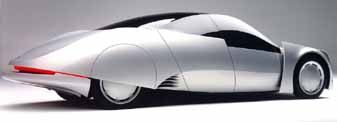
mid-size family car of 2010, according to Ford
compare Toyoto Prius
- when you widen roads then more people move further out of the city--amount of traffic increases to fill the roads
- what can you do?
- Europeans pay much higher
prices for gasoline because their governments pay
for road
improvements with money raised by the gasoline tax
(which means that
people pay taxes for roads roughly in proportion to how
much they use
them), while in the U.S. the money for road improvements
comes from
income and property taxes
- increase the cost: raise gas taxes, road pricing
- computer control of cars on the road--this allows smoother traffic flow so more cars can move faster on the same roads
- you may not like the idea, but some people think
this is
going to be the next big thing
This page written and copyright
Pamela E. Mack
